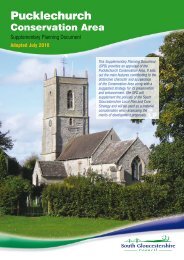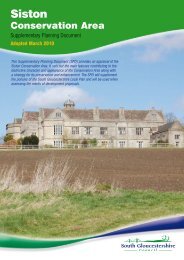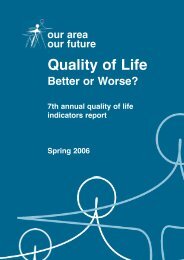The Roman villa at Badminton - South Gloucestershire Council
The Roman villa at Badminton - South Gloucestershire Council
The Roman villa at Badminton - South Gloucestershire Council
Create successful ePaper yourself
Turn your PDF publications into a flip-book with our unique Google optimized e-Paper software.
230524 06 203-212 (Colour) 11/1/10 14:53 Page 203<br />
Trans. Bristol & <strong>Gloucestershire</strong> Archaeological Society 127 (2009), 203–211<br />
<strong>The</strong> First <strong>Badminton</strong> House: discovery of a L<strong>at</strong>e <strong>Roman</strong><br />
mosaic in <strong>South</strong> <strong>Gloucestershire</strong><br />
By RICHARD OSGOOD<br />
Thomas Pigot (1657–1686)<br />
He haz some pieces of opus tessell<strong>at</strong>um found <strong>at</strong> or near Badmanton (the duke of Beauford’s) not<br />
long before his de<strong>at</strong>h 1<br />
Introduction<br />
In the l<strong>at</strong>er 17th century the antiquary John Aubrey (d. 1697) in the entry for Thomas Pigot in<br />
his Brief Lives gave a tantalising hint of the presence of a <strong>Roman</strong> mosaic on the duke of Beaufort’s<br />
est<strong>at</strong>e of <strong>Badminton</strong>. <strong>The</strong> Sites and Monuments Record contains this reference and one other<br />
rel<strong>at</strong>ing to excav<strong>at</strong>ions on the est<strong>at</strong>e by the duchess of Beaufort and Lord Albert Conyngham in<br />
1846 ‘in the park <strong>at</strong> <strong>Badminton</strong>, on the site of a <strong>Roman</strong> building’. Finds included much pottery,<br />
‘coins of the lower empire’, a bronze st<strong>at</strong>uette of a female figure and three intaglios ‘evidently l<strong>at</strong>e’<br />
(<strong>South</strong> <strong>Gloucestershire</strong> SMR 2140).<br />
<strong>The</strong> site lies close to the main <strong>Roman</strong> road between Cirencester (Corinium) and B<strong>at</strong>h (Aquae<br />
Sulis). ‘From Whitew<strong>at</strong>er cottages or Lansborough Park lodge for 5½ miles the road runs (as<br />
widened for traffic in the 18th and 19th centuries) pretty direct by <strong>Badminton</strong> past the Dunkirk<br />
to Sodbury camp, and on to Old Sodbury’ (St Clair Baddeley 1930, 162–3). <strong>The</strong> same author noted<br />
(ibid. 163, note 24) th<strong>at</strong> ‘Aubrey under 1686 (Monumenta Britannica: Bodleian) records a mosaic<br />
pavement having been found here, i.e., <strong>villa</strong>; a very interesting fact (cf. O.S. LXIX). Its exact site<br />
is not certain now, but is probably much nearer the road than the <strong>villa</strong> (v) on our map’. This was<br />
the totality of our understanding of <strong>Roman</strong>itas on the est<strong>at</strong>e until the summer of 2003.<br />
<strong>The</strong> excav<strong>at</strong>ion of the <strong>Roman</strong> buildings <strong>at</strong> nearby Lower Woods, Hawkesbury, in 2003 (Cosh<br />
2004, 4–6 and fig.1) revealed the presence of the remains of a mosaic. This pavement subsequently<br />
proved to have an inscription within its border; the first such mosaic in Britain – REG[ ]S (ibid.<br />
5 and fig. 2). <strong>The</strong> excav<strong>at</strong>ion was visited by the duke of Beaufort who gave his permission for a<br />
geophysical survey to be undertaken on the <strong>Badminton</strong> est<strong>at</strong>e. One area had been earmarked for<br />
such work by the est<strong>at</strong>e’s head forester, Mr Donald W<strong>at</strong>ts. Over the years he had recovered a spread<br />
of <strong>Roman</strong> m<strong>at</strong>erial from a specific site; limestone roof tiles, pot sherds and the occasional tessera.<br />
Aerial photographs of this area held by <strong>South</strong> <strong>Gloucestershire</strong> <strong>Council</strong> (AP Run 38/204) show<br />
possible trackways leading to this loc<strong>at</strong>ion and nearby traces of ridge and furrow. Grumbald’s Ash<br />
Archaeology Group, the team th<strong>at</strong> had excav<strong>at</strong>ed Lower Woods, carried out a resistivity survey<br />
in the summer of 2003 with astonishing results (Fig. 1).<br />
1. John Aubrey, Brief Lives chiefly of Contemporaries set down by John Aubrey between the Years 1669 and 1696,<br />
ed. A. Clark (Oxford, 1898), 155.
230524 06 203-212 (Colour) 11/1/10 14:53 Page 204<br />
204 RICHARD OSGOOD<br />
Fig. 1. Resistivity survey of the area of the <strong>Badminton</strong> <strong>villa</strong> undertaken by Grumbald’s Ash Archaeological<br />
Group in 2003 (© A.W. Jackson, M.H. and J. Martin, Sagascan).<br />
<strong>The</strong> Site<br />
<strong>The</strong> survey of the area with the spread of <strong>Roman</strong> m<strong>at</strong>erial mentioned above, centred on OS N<strong>at</strong>.<br />
Grid ST 81028584 (Fig. 2), revealed a large building, some 65 m in length, with <strong>at</strong> least two smaller<br />
buildings just to the east possibly surrounding a garden or w<strong>at</strong>er fe<strong>at</strong>ure (Bryn Walters pers.<br />
comm.). All of the structures seemed to be enclosed by the walls in an area trapezoidal in shape<br />
(Fig. 3). Of particular interest was the room on the northern end of the largest building as the<br />
survey showed it to be, on its east side, apsidal in form. A sample trench in th<strong>at</strong> area showed th<strong>at</strong><br />
limestone walls of a structure remained in situ. All of the walls exposed were still covered by<br />
remnants of the original <strong>Roman</strong> wall plaster. This was coloured salmon pink with splashes of purple<br />
but many other fragments of colour were also present. On extension of the trench, it soon became<br />
apparent th<strong>at</strong> the walls lay adjacent to a phenomenal mosaic, some 60 m², covering the floor of<br />
the apsidal room and the corridor th<strong>at</strong> led to it.<br />
<strong>The</strong> building had caught fire and collapsed. P<strong>at</strong>ches of timber scorching were present on the<br />
mosaic and one p<strong>at</strong>ch of linear burning (presumably an individual timber) was especially clear over
230524 06 203-212 (Colour) 11/1/10 14:53 Page 205<br />
A LATE ROMAN MOSAIC AT BADMINTON 205<br />
Fig. 2. Loc<strong>at</strong>ion of the survey area on the <strong>Badminton</strong> est<strong>at</strong>e.<br />
the rays of colour eman<strong>at</strong>ing from the central roundel within the apse. Large fragments of oak<br />
charcoal were recovered from this layer – the last remnants of these timbers. <strong>The</strong> collapse had<br />
covered the floor with building detritus, in particular pennant roof slabs th<strong>at</strong> had, ironically,<br />
afforded the floor some protection from subsequent ploughing and ensured its preserv<strong>at</strong>ion. Almost<br />
none of the stones th<strong>at</strong> made up the walls of the apse-ended room survived. <strong>The</strong> only surviving
230524 06 203-212 (Colour) 11/1/10 14:53 Page 206<br />
206 RICHARD OSGOOD<br />
Fig. 3. Schem<strong>at</strong>ic plan (north to the top) of the major structures revealed by the survey; the apse-ended<br />
room is highlighted.<br />
walls seen were those mentioned above, covered with painted wall plaster and demarc<strong>at</strong>ing the<br />
area of the corridor. <strong>The</strong> site was covered and then re-opened in the summer of 2004.<strong>The</strong> carefully<br />
worked stones of an arch, th<strong>at</strong> would have been present in the apse region of the room, were found<br />
within the collapse layers and the respond of this arch was loc<strong>at</strong>ed <strong>at</strong> the edge of the mosaic floor<br />
(Osgood 2004, 29).
230524 06 203-212 (Colour) 11/1/10 14:53 Page 207<br />
A LATE ROMAN MOSAIC AT BADMINTON 207<br />
<strong>The</strong> Photography of the Mosaic<br />
Following consult<strong>at</strong>ions with English Heritage Photogrammetric Unit (Survey Team), it was<br />
decided th<strong>at</strong>, alongside the prepar<strong>at</strong>ion of a coloured scale drawing on site by David Neal, the most<br />
accur<strong>at</strong>e and vers<strong>at</strong>ile methodology for recording the <strong>Badminton</strong> mosaic would be through the<br />
production of a rectified photograph in a fashion similar to th<strong>at</strong> of the Lopen pavement in Somerset<br />
(URL cited in bibliography). Thus in 2004 a photograph of the mosaic in the apse-ended room<br />
and the corridor was taken by Downland Survey and Measurement. Downland used site<br />
photography with control measurements, the images rectified using Rollei MSR software. <strong>The</strong><br />
resulting photograph (Fig. 4) ensures th<strong>at</strong> researchers will be able to take accur<strong>at</strong>e measurements<br />
of the pavement from the scaled image. <strong>The</strong> remit of this article is to report the result of this survey<br />
and to draw together some expert opinions on the mosaic. A full report on the excav<strong>at</strong>ion work<br />
of 2003 and 2004 will be produced <strong>at</strong> a l<strong>at</strong>er d<strong>at</strong>e.<br />
Opinions on the Mosaic<br />
Since the discovery of the pavement, much deb<strong>at</strong>e has raged over its quality. Was it constructed<br />
by craftsmen with little skill, <strong>at</strong>tempting to copy floors which they had seen but without the<br />
requisite competencies to accomplish the task, or was the mosaic fashioned by an expert team th<strong>at</strong><br />
felt unfettered by the normal restraints th<strong>at</strong> encumbered the mosaicist and thus able to apply more<br />
artistic touches? In passages worth quoting <strong>at</strong> length, the arguments of the two schools of thought<br />
are put forward below.<br />
On the subject of the mosaic floors in both the corridor and apsidal room, Stephen Cosh, coauthor<br />
with David Neal of the ambitious and sumptuous corpus of <strong>Roman</strong> mosaics in Britain, wrote<br />
(2004, 4):<br />
Two mosaics were exposed. One, paving a passage is rel<strong>at</strong>ively simple, comprising a coarse purplishbrown<br />
pennant stone border with a band of white about 0.60 m wide running down its centre and relieved<br />
by blue double fillets <strong>at</strong> the margins. <strong>The</strong> neighbouring room with an apse has a large well-preserved<br />
mosaic, which, although ambitious in concept, is rel<strong>at</strong>ively crude in execution, although the geometry,<br />
while unusual is accur<strong>at</strong>e….<strong>The</strong> centrepiece is a guilloche knot with excrescences. Between the responds,<br />
and flanked by squares of guilloche containing knots, is a medallion with an unusual flower comprising<br />
bifurc<strong>at</strong>ing stems termin<strong>at</strong>ing in pairs of inward-pointing heart-shaped petals….Its style and associ<strong>at</strong>ed<br />
finds possibly indic<strong>at</strong>e a l<strong>at</strong>e fourth-century d<strong>at</strong>e.<br />
Another expert on <strong>Roman</strong> mosaics, Anthony Beeson (forthcoming), took a differing view of the<br />
skills of the artisans involved:<br />
<strong>The</strong> new work shows how colourful and artistically impressive the floor is. Geometric mosaics were common<br />
in <strong>Roman</strong> Britain and the same designs and devices were employed and copied by mosaicists<br />
throughout the province. Wh<strong>at</strong> is remarkable about the large pavement <strong>at</strong> <strong>Badminton</strong> Park, particularly<br />
the apsed area, is th<strong>at</strong> it employs motifs so far unique in mosaic anywhere. It is obvious th<strong>at</strong> the room was<br />
designed to hold a stibadium, a curved dining couch. <strong>The</strong> design in the apse is surrounded by a broad band<br />
of plain tessell<strong>at</strong>ion affording plenty of room for an impressive ‘C’-shaped couch to be placed on it and<br />
yet still leave room for about half of the fan-shaped radiant design to be seen by the diners. A guillochebordered<br />
roundel shows where the circular table would have stood for their convenience…<br />
It is the device found in this roundel th<strong>at</strong> is the most exciting fe<strong>at</strong>ure of the floor. One is used to the<br />
petalled rosettes used in this manner as on the new mosaic from Bradford-on-Avon. Wh<strong>at</strong> is remarkable<br />
here is th<strong>at</strong> the normal petals have been turned into double leaves on shared ‘Y’-shaped stems. A variant<br />
of the same device appears in the lunettes <strong>at</strong> each end of the main rectangular section of the mosaic. This
230524 06 203-212 (Colour) 11/1/10 14:53 Page 208<br />
208 RICHARD OSGOOD<br />
part of the floor also has an unusual design. <strong>The</strong> mosaicist has based the p<strong>at</strong>tern on a conventional scheme<br />
of interlaced squares, but has tilted those in the corners and thereby enlivened the design. Bright p<strong>at</strong>terned<br />
areas of blue and white chequer work vie for <strong>at</strong>tention with diamond-shaped panels containing<br />
another stylized and unique device extremely reminiscent of Jupiter’s thunderbolt. <strong>The</strong> whole floor is<br />
remarkable. It is as though the mosaicist (who was obviously perfectly au-fait with conventional geometric<br />
designs) decided to completely break from the slavish tradition and re-interpret motifs using the<br />
artist’s eye r<strong>at</strong>her than the ruler. Artistically this is the most exciting geometric floor to have been discovered<br />
in Britain for many years).<br />
Wh<strong>at</strong>ever the truth, the pavement is of such a size and of such preserv<strong>at</strong>ion as to render it one of<br />
the most important <strong>Roman</strong> discoveries of recent years in the region. It may also go some way to<br />
filling a clear gap in our understanding of <strong>Roman</strong> <strong>South</strong> <strong>Gloucestershire</strong> – the distribution map<br />
of <strong>Roman</strong> sites within the former county of Avon (Aston and Iles 1987) being radically altered in<br />
recent years and hence the conclusions th<strong>at</strong> authors are able to draw.<br />
<strong>The</strong> Construction of the Mosaic<br />
Once the walls of the apsidal room were built, the mosaic was added, and then the walls were<br />
plastered and painted – there were clear p<strong>at</strong>ches of plaster th<strong>at</strong> covered the floor. <strong>The</strong> project was<br />
fortun<strong>at</strong>e enough to draw upon the expertise of someone who was examining a series of mosaics<br />
within the <strong>Roman</strong> world. As part of his D.Phil. thesis <strong>at</strong> Queen’s College, Oxford, William<br />
Wootton studied the construction techniques employed on the <strong>Badminton</strong> mosaic. <strong>The</strong> border<br />
tesserae were pennant stone, purples, blues and greens. <strong>The</strong> p<strong>at</strong>terns were picked out in white<br />
and blue lias limestones, with orange/red tesserae of terracotta.<br />
As mentioned above, the roof of the room crashed down in a fire damaging the mosaic in places.<br />
Where tesserae were dislodged or loosened by this event, the make-up of the floor was revealed.<br />
Following removal of the covering layers of roof slabs and charred m<strong>at</strong>erial it was possible to<br />
investig<strong>at</strong>e the structure of the floor. It was found th<strong>at</strong> the individual tesserae were set down into<br />
wet mortar – where an individual tessera was missing, its ‘ghost’ could still be seen in the remaining<br />
mortar. This mortar, grey-white in colour and flecked with small fragments of terracotta utilised<br />
as an aggreg<strong>at</strong>e (the nucleus), was itself laid over a footing of rammed sand. This sand lay on top<br />
of the n<strong>at</strong>ural subsoil clay and was thus perhaps a slighter found<strong>at</strong>ion than th<strong>at</strong> afforded many other<br />
mosaics, certainly well below the blueprint prescribed by the architect Vitruvius (30–20 BC – see<br />
Ling 1998, 11).<br />
<strong>The</strong> mosaic had also undergone <strong>at</strong> least one element of repair before the destruction of the room;<br />
in the second band of the rays within the apse, on the northern side of the pavement, tesserae of<br />
wh<strong>at</strong> had originally been white and blue lias and pennant, had been replaced with no care as to<br />
the colour chosen. Other, single, tesserae had also been replaced in ‘incorrect’ colours. One reason<br />
for believing th<strong>at</strong> these are evidence for repairs is th<strong>at</strong> the <strong>Badminton</strong> Park mosaicists had been<br />
aware of the importance of precise use of colour. This is born out by the fifth ‘ray’ of the fanshaped<br />
design (starting from the left in a clockwise direction). Here, the upper colour-band is blue<br />
lias with a lower band of purple pennant – this is a reversal of the design of the first four ‘rays’<br />
and would have ensured th<strong>at</strong> the final ‘ray’ would close with the required blue band to correctly<br />
seal the guilloche knot. Another oddity in terms of colour<strong>at</strong>ion was the large pennant square loc<strong>at</strong>ed<br />
in the central white panel of the corridor th<strong>at</strong> led to the apsed room. It appeared to have been<br />
placed deliber<strong>at</strong>ely r<strong>at</strong>her than to have been a replacement of damaged or missing tesserae.
230524 06 203-212 (Colour) 11/1/10 14:54 Page 209<br />
A LATE ROMAN MOSAIC AT BADMINTON 209<br />
Fig. 4. Rectified photograph of the <strong>Badminton</strong> pavement taken by Downland Survey and Measurement<br />
and revealing its lack of symmetry and areas of damage to it.
230524 06 203-212 (Colour) 11/1/10 14:53 Page 210<br />
210 RICHARD OSGOOD<br />
Wh<strong>at</strong> happened to the pavement?<br />
From the geophysical survey Bryn Walters hypothesised th<strong>at</strong> the scan shows much about the form<br />
of the building with the apse being an <strong>at</strong>tempt to maintain the symmetry of the building – a b<strong>at</strong>h<br />
building added to one side and the apse-ended room to the other. <strong>The</strong> apsidal room certainly<br />
appears to have been added to the original structure and was aligned east–west with the apse <strong>at</strong><br />
the east end. Although there were no str<strong>at</strong>ified coins and little by way of small finds within the<br />
str<strong>at</strong>igraphy of the room, the pottery seems to indic<strong>at</strong>e th<strong>at</strong> this room was l<strong>at</strong>e, possibly constructed<br />
in the mid 4th century. Perhaps the <strong>at</strong>tempt to maintain the symmetry of the site might indic<strong>at</strong>e<br />
th<strong>at</strong> this was an important family se<strong>at</strong> over several gener<strong>at</strong>ions and thus an important precursor<br />
of the current <strong>Badminton</strong> House.<br />
As mentioned, this room <strong>at</strong> least appears to have been subject to a major fire – either the cause<br />
of abandonment or its immedi<strong>at</strong>e precursor. <strong>The</strong> floor was covered by the remains of pennant<br />
roof slabs which had crashed onto the mosaic. <strong>The</strong> vast majority of finds from levels within the<br />
room were iron nails which were connected with the roof structure. Unlike the mosaic <strong>at</strong><br />
Hawkesbury, there was no evidence for l<strong>at</strong>er use of the pavement as a surface, there being neither<br />
obvious postholes cut through the mosaic nor evidence of the clearance of the collapsed debris<br />
from it. At some stage most of the stones of the walls had been robbed.<br />
Conclusion<br />
This was far from being an ordinary <strong>villa</strong>. It was probably akin to a vast country residence. With<br />
two <strong>villa</strong>s potentially in a courtyard (perhaps linked by corridor) and a trapezoidal enclosure it has<br />
elements of a continental layout to it – perhaps like Seeb in Switzerland (Bryn Walter pers. comm.).<br />
As Ling has pointed out (1998, 134–5), the motives which inspired a p<strong>at</strong>ron to commission a<br />
particular mosaic were as many and varied as our current appreci<strong>at</strong>ion of the pavements. Wh<strong>at</strong>ever<br />
the skills of the mosaicists involved in the construction of the <strong>Badminton</strong> mosaic and wh<strong>at</strong>ever<br />
‘school’ of work they based their designs on, the <strong>Badminton</strong> mosaic survives as an exceptional find.<br />
Following the photography of the pavement, the site was carefully backfilled to ensure it will last<br />
for many future gener<strong>at</strong>ions.<br />
Acknowledgements<br />
<strong>The</strong> mosaic would not have been discovered had it not been for the kind permission of His Grace<br />
the duke of Beaufort for work to proceed and the persistence of Donald W<strong>at</strong>ts in researching all<br />
the archaeological sites of the est<strong>at</strong>e. <strong>The</strong> survey of the site and most of the backbreaking work<br />
was carried out by Michael and Jill Martin, Andrew Jackson and Rebecca Ireland, ably assisted by<br />
many volunteers. My thanks are due to the following individuals who visited the site and made<br />
comments on the mosaic and other elements of the archaeology – Mark Corney, Bryn Walters,<br />
Anthony Beeson, Graham Soffe, P<strong>at</strong> Witts and Michael Stone. David Neal and Stephen Cosh also<br />
lent their expertise on m<strong>at</strong>ters concerning mosaics. As ever, my friend Martin Henig was generous<br />
with his invaluable advice and thoughts as was William Wootton. David Evans, Historic<br />
Environment Record Officer of <strong>South</strong> <strong>Gloucestershire</strong> <strong>Council</strong>, traced all known elements<br />
connected to the site and examined the small amount of pottery recovered.<br />
Funding for this work was provided by <strong>South</strong> <strong>Gloucestershire</strong> <strong>Council</strong> and a £500 Irene<br />
Bridgeman Research Grant from the Bristol and <strong>Gloucestershire</strong> Archaeological Society. To them<br />
my thanks are here acknowledged.
230524 06 203-212 (Colour) 11/1/10 14:53 Page 211<br />
Bibliography<br />
A LATE ROMAN MOSAIC AT BADMINTON 211<br />
Aston, M., and Iles, R. (eds.), 1987. <strong>The</strong> Archaeology of Avon (Avon County <strong>Council</strong>, Bristol).<br />
Beeson, A.J., forthcoming. ‘New Mosaic Discoveries in the <strong>South</strong> West’, Associ<strong>at</strong>ion for <strong>Roman</strong> Archaeology.<br />
Cosh, S.R., 2004. ‘<strong>Roman</strong> Mosaics in 2003’, Mosaic 31, 4–6.<br />
Ling, R., 1998. Ancient Mosaics (British Museum, London).<br />
Neal, D., and Cosh, S.R., 2002. <strong>Roman</strong> Mosaics of Britain 1: Northern Britain (Illumin<strong>at</strong>a for the Society of<br />
Antiquaries of London).<br />
Osgood, R.H., 2004. ‘<strong>The</strong> <strong>Roman</strong> Mosaic <strong>at</strong> <strong>Badminton</strong>’, <strong>Council</strong> for British Archaeology <strong>South</strong>-West 12, 28–9.<br />
St Clair Baddeley, W., 1930. ‘Notes on portions of a L<strong>at</strong>e and Secondary <strong>Roman</strong> Road-System in<br />
<strong>Gloucestershire</strong>’, Trans. BGAS 52, 151–85.<br />
URL for the Lopen mosaic: http://www.lopenmosaic.co.uk (accessed 4 June 2004); details on the photogrammetric<br />
survey are loc<strong>at</strong>ed <strong>at</strong> http://www.lopenmosaic.co.uk/pdfs/photogrammetry.pdf

















